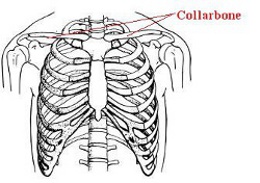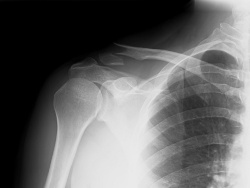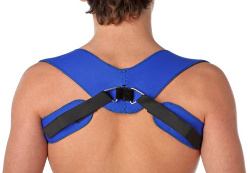Collarbone pain is usually associated with bone fractures and injuries, that are caused by direct blows to the collarbone, or injuries to the shoulder. Sometimes degeneration of the cartilage, or a bone infection can also lead to clavicle pain. The following write-up provides information on the causes, symptoms, and treatment of collarbone pain.

The collarbone or clavicle is a short, curved bone, that extends from the middle of the chest to the shoulders. Located just over the top rib, the clavicle connects the upper arms to the body. Its basic function is to serve as a strut or a rigid support, between the shoulder blade (scapula) and the arms. This allows maximum movement of the arms. The clavicle also helps in transmitting any impact, or weight on the upper limbs to the central part of the body.
It is easy to feel the collarbone in the body, between the neck and the shoulders. This is because, unlike other bones in the body which are covered with muscles, the collarbone lies very close to the skin. This also makes the collarbone increasingly prone to a number of injuries, fractures, and resultant pain. In fact, clavicle fractures are the most common instances of broken bones, especially in football, and hockey players. Here are some of the common causes, and symptoms of collarbone pain.
Causes of Collarbone Pain
Broken Collarbone

Collarbone injuries that lead to a broken collarbone or fractures, are caused by sports injuries, falling on the shoulders, or on the outstretched hand when breaking the fall. Vehicle accidents, or direct blows to the shoulder can lead to injuries to the clavicle.
In newborns, the clavicle may be fractured during a difficult vaginal delivery. Children and adolescents are also prone to collarbone injuries, as the clavicle ossifies, and develops only in the late teenage years.Symptoms
A collarbone fracture can cause extreme pain to the upper chest and shoulders, especially during movement. The person may be unable to move his or her arms. Sometimes, forced movement can cause a popping, or a clicking sound. Due to the absence of muscular cover, the obvious bone deformity is visible as a lump on the shoulder, or along the bone where there is a fracture. This can be accompanied by swelling, bruising and tenderness in the affected part. The extreme pain can also cause nausea and dizziness.
In babies, the broken clavicle cannot be seen or felt. However, the child may refuse to move the arm, or hold it against the side of his or her body. After a few days, when the bone starts healing, a bulge can be seen on the collarbone.
Treatment

The best treatment for a fractured collarbone is immobilizing the affected arm, and supporting the shoulder with a sling, or a "clavicle strap". Clavicle straps are foam padded shoulder straps that provide support to the broken bones, and hold it in place till the bones heal. Once the sling is removed, physical therapy may be needed to restore the strength in the shoulders.
To reduce the pain and inflammation, ice packs can be applied on the shoulder. It takes approximately twelve weeks for the clavicle fractures to heal completely in adults. If the fracture is severely displaced, or if there is any skin penetration, then surgery might be required.
Acromioclavicular (AC) Joint injuries
Apart from the muscles, ligaments and tendons, the shoulder is made up of three bones; the collarbone, shoulder blade, and the large bone in the upper arm, also known as humerus. The acromioclavicular joint connects the acromion (The outer end of the shoulder blade) and clavicle. It is stabilized by three ligaments. When these ligaments are sprained or torn, then it can cause AC joint injuries. Direct blows to the shoulders, traumatic contact from the sides, or overstressing the joints while lifting heavy weights, are some of the common causes of this joint injury.
Symptoms
Based on the severity of the injury, there is immediate pain and swelling, along with a visible displacement of the collarbone. This pain is aggravated, when a person is engaged in activities like pushing, pulling, or reaching overhead.
Treatment
These painful joint injuries restrict the full range of motion. In case of minor sprains of the ligaments, physical therapy can be started after a few weeks, to regain the strength of the joints. In case of fractures, the conservative treatment with slings are recommended. Only in severe cases, where there is clavicle dislocation, surgical reconstruction of the torn coracoclavicular ligaments can be done.
Osteoarthritis of the Acromioclavicular(AC) joint
With constant wear and tear, there is a degeneration of the articular cartilage that cushions, and acts as a shock absorber for the acromioclavicular joint. Apart from age, the most common cause of the osteoarthritis is lifting heavy weights overhead. Sometimes, a joint injury can also trigger off the degeneration of the joint.
Symptoms
Osteoarthritis of the AC joint triggers off pain, and tenderness in the shoulders, the front of chest and neck. This is aggravated when the joints are compressed by motions like, crossing the arm across the chest. The collarbone pain is often mild and throbbing.
Treatment
The best non-surgical treatment for the osteoarthritis is rest, and anti-inflammatory medications. For extreme pain and inflammation, the doctor might recommend cortisone injections. Surgical treatment, in the form of resection arthroplasty, is done in severe cases. A small portion of the outer end of the clavicle is removed, so that there is a space between the clavicle and acromion. This prevents friction, and eases the movement of the joints.
Acute Osteomyelitis of the Clavicle
Osteomyelitis is the medical term for infection of the bones. In majority of the cases, the bone infection is caused by bacteria. Acute osteomyelitis is when the infection develops after an injury, or an infection. The bone infection can also be passed on through the bloodstream. Osteomyelitis of the clavicle is extremely rare. It mostly occurs after a neck or head surgery.
Symptoms
The most common symptoms of osteomyelitis are extreme clavicle pain, fever, and swelling. The affected area may appear warm and red.
Treatment
Intravenous antibiotic treatment, for around six to eight weeks, is the preferred course of treatment for osteomyelitis of the clavicle. In severe cases, surgery might be required.
Distal Clavicular Osteolysis
Clavicular osteolysis, also known as weightlifter's shoulder, is caused by the fractures in the distal end of the clavicle. Constant stress on the shoulders, and excessive pressure on the AC joint, when lifting heavy weights, or doing bench presses can lead to this problem.
Symptoms
Pain in the shoulders and joints can be felt, especially when the joints are pressed. Lying on the side while sleeping, can worsen the pain.
Treatment
Rest, and modification of the exercise routine can help in easing the collarbone pain. In case, the non-surgical measures fail to improve the condition, surgical procedures like distal clavicle resection may be an option.
Other causes of collarbone pain include, radiating pain from injuries to the ribs, shoulders, chest and rotator cuff. Bone diseases may also cause pain in the clavicle and shoulders. The treatment of the collarbone pain is dependent on the underlying cause. Both non-surgical and surgical measures are employed. To prevent clavicle pain, it is important to stick to a good conditioning program, and wear protective equipment, like shoulder pads to avoid sports related injuries to the collarbone.
Disclaimer: The information provided in this article is solely for educating the reader. It is not intended to be a substitute for the advice of a medical expert.


 The collarbone or clavicle is a short, curved bone, that extends from the middle of the chest to the shoulders. Located just over the top rib, the clavicle connects the upper arms to the body. Its basic function is to serve as a strut or a rigid support, between the shoulder blade (scapula) and the arms. This allows maximum movement of the arms. The clavicle also helps in transmitting any impact, or weight on the upper limbs to the central part of the body.
The collarbone or clavicle is a short, curved bone, that extends from the middle of the chest to the shoulders. Located just over the top rib, the clavicle connects the upper arms to the body. Its basic function is to serve as a strut or a rigid support, between the shoulder blade (scapula) and the arms. This allows maximum movement of the arms. The clavicle also helps in transmitting any impact, or weight on the upper limbs to the central part of the body.
 The best treatment for a fractured collarbone is immobilizing the affected arm, and supporting the shoulder with a sling, or a "clavicle strap". Clavicle straps are foam padded shoulder straps that provide support to the broken bones, and hold it in place till the bones heal. Once the sling is removed, physical therapy may be needed to restore the strength in the shoulders.
The best treatment for a fractured collarbone is immobilizing the affected arm, and supporting the shoulder with a sling, or a "clavicle strap". Clavicle straps are foam padded shoulder straps that provide support to the broken bones, and hold it in place till the bones heal. Once the sling is removed, physical therapy may be needed to restore the strength in the shoulders.